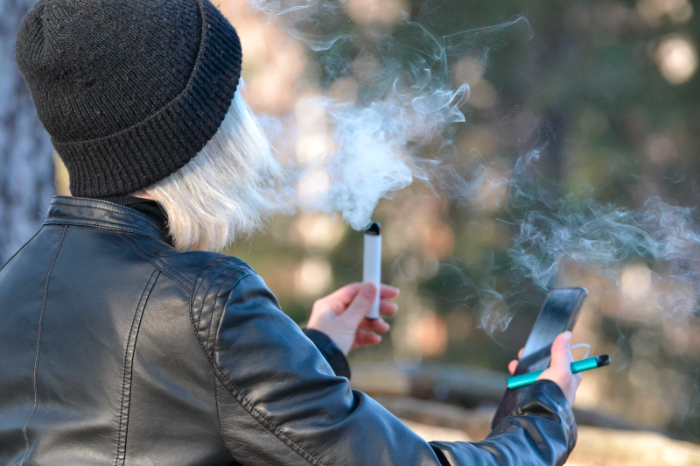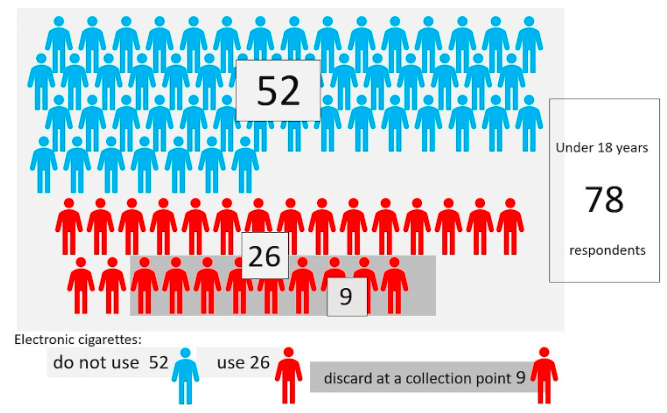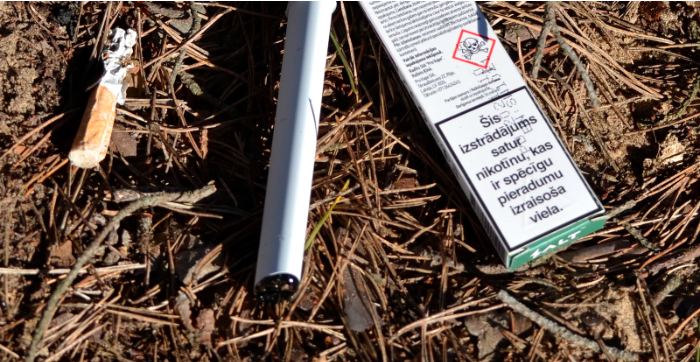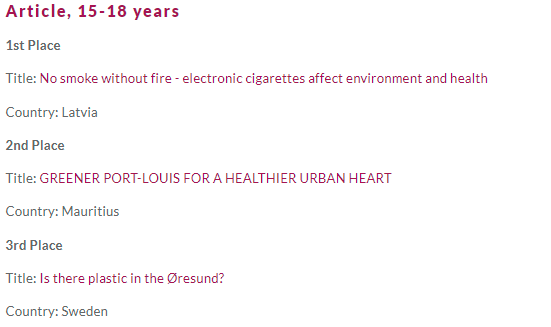YRE Competition 2022
1st Place - Article
15-18 years old
By: Roze Aleksa Bogdane
Electronic cigarettes are now very popular among young people and have become an attribute of style. They are sold with different liquids that give the smoke different flavours, and the smell is pleasant, so parents often do not realize that their child smokes. Some people believe that the amount of nicotine in e-cigarettes is insignificant and does not cause addiction or affect the environment. Rarely does anyone think about waste from used cigarettes. Is it really "smoke without a fire"? Are e-cigarettes just an innocent form of entertainment?
Photo: Roze Aleksa Bogdane
There are various types of electronic cigarettes and they function in different ways - there are refillable tobacco heaters, but disposable vapes are the most popular. The information on the packaging states that the product contains up to 450 inhalations, which manufacturers equate to one pack of 20 cigarettes. The packaging also states that the empty cartridge must not be disposed in household waste but in the appropriate collecting containers.
Gateway to smoking
Although Latvian and European Union legislation prohibits the sale of e-cigarettes to persons under the age of 18 [1], they are relatively easy to obtain because they can be purchased online or from adult friends. In a survey on electronic cigarette usage habits among young people in Latvia 78 out of 130 respondents were under the age of 18, but 26 of them already use or have used e-cigarettes. The data show a high prevalence among adolescents - a lot of them use, have used or use e-cigarettes in the company of friends. Only nine of the youngsters said that they dispose of empty cartridges at the collecting points. [2]
Infogram: Roze Aleksa Bogdane, Data on the use of e-cigarettes for respondents under 18 years
A study done by the Centre for Disease Prevention and Control also shows that in 2019, a total of 51.3% of 13–15-year-olds have tried electronic cigarettes. The proportion of those who have tried to use has increased significantly since 2011, especially for boys and 15-year-olds from 24% in 2011 to 61.6% in 2019. [3]
A similar situation is also in other countries e.g., in the United States of America (USA). According to the Centre for Disease Control and Prevention (CDC) between 2017 and 2018, the use of e-cigarettes in the USA among high school students increased by 48% which made the CDC call it an "epidemic". Several states have now banned flavoured e-cigarettes altogether.[4]
On April 16, 2021, Scientific Committee on Health, Environmental and Emerging Risks published an opinion on e-cigarettes, stating that e-cigarettes are a gateway to smoking, especially for young people. There is strong evidence that nicotine in e-cigarette liquids is associated with the development of addiction, but the flavours have a significant effect on making e-cigarettes more attractive.[5]
Are they less harmful than regular cigarettes?
48% of respondents in the survey admit that they are not aware of the e-cigarette impact on the environment. Individual respondents consider e-cigarettes safer than traditional nicotine cigarettes.[2]
Environmental scientist and chemist Jana Simanovska says: "The end of cigarettes consists of cellulose acetate, which degrades in the environment from one up to 10 years. They contain a variety of toxic substances that are toxic to living organisms that encounter them. Do vapes seem to be an alternative? Not at all. They are also thrown into the environment, but now there is also a toxic battery, environmentally harmful metals and plastics that will not degrade during our lifetime and will pollute the environment for much longer."[6]
Jana Simanovska points out that the CDC study warns of the dangers of e-cigarettes, especially for teenagers, as they permit users to take in unlimited amounts of nicotine. In addition, to make the smoke more pleasant, they contain a whole bouquet of fragrances, the dangers of which we know little about.[6]. "People just need to know that they're inhaling a very complex mixture of chemicals when they vape. And for a lot of these compounds, we have no idea what they are. I have a problem with how vaping is being marketed as healthier than smoking cigarettes. In my opinion, we are just not at the point when we can really say that." [7]
Photo: Roze Aleksa Bogdane
Analyzing the impact of e-cigarettes on environmental pollution, Jānis Ulme environmental expert and leader of the My Sea campaign, says that smoking waste is a very topical problem, as it is one of the largest marine pollutants in the world. At present, in addition to cigarette butts, various new smoking wastes from e-cigarettes are appearing with a rapidly growing trend both in Latvia and globally. The hazardous waste contained in disposable e-cigarettes like toxic batteries and liquid residues enters the environment.[8]
These products are becoming popular among adolescents and they are creating a toxic waste stream. And it’s not a trivial amount of waste. We are talking about billions of e-cigarette waste items each year. And that is a global problem, say researchers from the University of California, San Francisco.[9]
Jānis Žagars, a representative of the Latvian electronic cigarette manufacturer Pro Vape SIA, emphasizes: "We have set a good example compared to other manufacturers of environmentally unwanted products and packaging, as we provide the opportunity to dispose of used products free of charge at sales outlets, thus collecting about 30 % of used products." The company also informs that the waste is further recycled in an environmentally friendly way at its own expense but adds that it will always be the user's responsibility where the used plastic bags, tires or e-cigarettes are being disposed.[10]
Environmental activist Jānis Ulme, on the other hand, highlight that the device contains dozens of different parts, which, due to the small percentage of collection and technically difficult disassembly, are not actually recycled in practice. There are still no fundamental examples of good practice in the world or even long-standing research about the influence of the disposed e-cigarettes.[8]
The smoke of disposable cigarettes 450 breathes costs nature a lot, creates non-recyclable, hazardous waste and promotes disposable consumption.
Jānis Ulme's recommendation for the necessary action is categorical: "Well, in my opinion, in the context of the EU's Plastics Strategy [11], such disposable devices should not be marketed and manufactured at all. However, this seems too dreamy," adds Ulme. "If they are produced and distributed, stricter ecodesign principles should be set so that many fractions can be easily dismantled and recycled after use, and claims for return - at least an individual deposit, when a new one cannot be bought without transferring the previous one. In my opinion, the first answer would be more concrete legislative action to regulate this industry."[8]
The WHO Framework Convention on Tobacco Control sets out controls and a set of measures to reduce cigarette and tobacco consumption, such as monitoring tobacco use and prevention policies, education on the danger of tobacco use etc. [12],[13] This is an important agreement for society as a whole, which also applies to e-cigarettes, as the prevalence of smoking is a global problem with serious consequences not only for health but also for the environment.
REFERENCES:
2. The author's survey in Google Forms 130 respondents, 02.2022.
4. Home | Center for Tobacco Control Research and Education (ucsf.edu)
5. https://ec.europa.eu/health/system/files/2021-04/scheer_o_017_0.pdf
6. Interview in e-mail with Jana Simanovska, dr.sc.ing., leads the society “Ecodesign Competence Center”, 02.02-18.02.2022.
8. Interview in e-mail with Jānis Ulme, the head of the Foundation for Environmental Education Latvia and leader of the My Sea campaign 02.02-18.02.2022.
10. Personal correspondence in e-mail with Jānis Žagars, Head of marketing Pro Vape / SALT switch, 01.05-05.05.2022.
11. EUR-Lex - 52018DC0028 - EN - EUR-Lex (europa.eu)
12. PVO vispārējā konvencija par tabakas uzraudzību (likumi.lv)
13. World Health Organization. (2019). WHO report on the global tobacco epidemic, 2019: offer help to quit tobacco use. World Health Organization. Available here: https://apps.who.int/iris/handle/10665/326043?locale-attribute=pt&
DISSEMINATION:
Author`s social media:
https://issuu.com/roze.aleksa/docs/raksts
National Operator:
https://www.facebook.com/videsfonds/posts/5638927492813543
https://www.instagram.com/p/CdbN6JFLUUw/
Local and national news portals:
YRE Hub:




